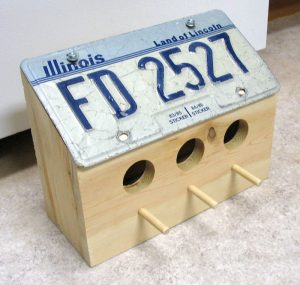Last Updated on March 12, 2024 by teamobn
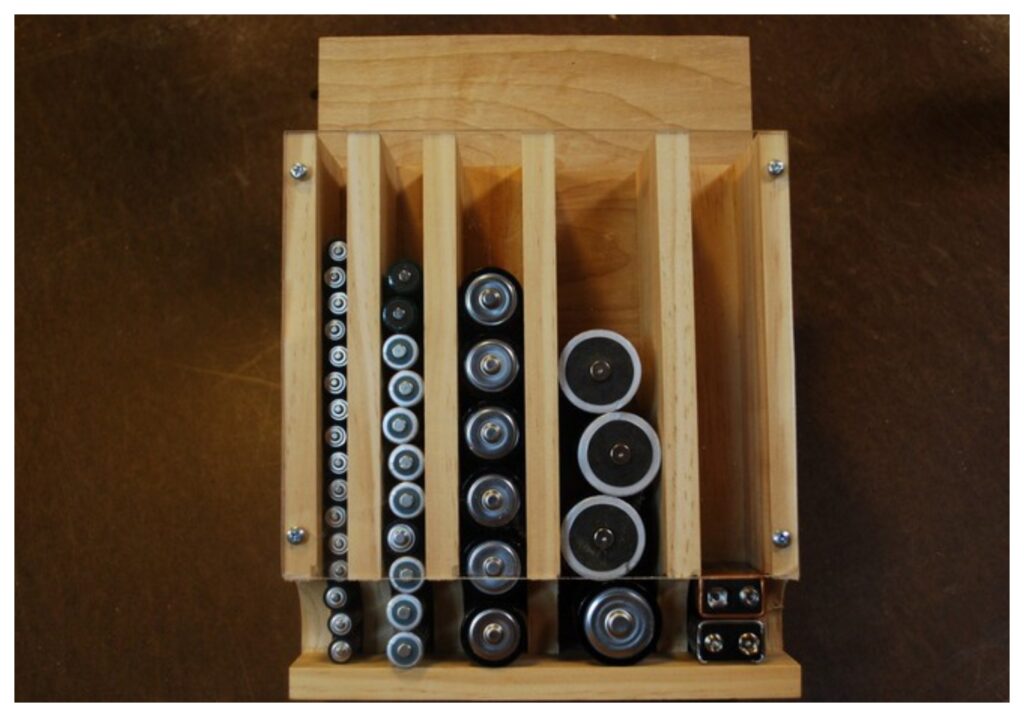
Batteries are an essential part of many common household items. Remotes, flashlights, cameras, and smoke alarms all require batteries to function. Even the mouse you’re using right now likely contains a battery. While batteries are small and often taken for granted, they play a big role in our daily lives. Without batteries, many of the devices we rely on would be rendered useless. That’s why it’s important to always have fresh batteries on hand, so you’re never left without power when you need it most.
While they are relatively safe to use, there are some dangers to be aware of when storing batteries. Batteries can leak chemicals that can be harmful if ingested or inhaled. If the battery leaks, be sure to clean up the area immediately and ventilate the room. Batteries can also catch fire if they are damaged or improperly used. Always follow the manufacturer’s instructions for safety.

Well, how do you store your batteries? If you’re like most people, you probably store your batteries in a drawer or some other haphazard way. But did you know that there’s a better way to store batteries? With this DIY battery storage project, you can easily and inexpensively organize your batteries so that you can find the one you need when you need it.
However, when storing batteries, it is important to keep them in a cool, dry place. Extreme temperatures can cause batteries to leak or catch fire, so it is best to avoid storing them in areas that are subject to extreme heat or cold. Additionally, batteries should be kept away from children and pets, as they can be dangerous if handled improperly.
There are many battery organizers available in stores and online, but this homemade battery dispenser is another great option that you can make using a few timber off-cuts!
This drop-down battery dispenser is one of the best ways to organize your supply, as it uses the first in first out method. This ensures that you are always using the freshest batteries, which will perform at their best. With this system, you can make sure you get the oldest, unused battery (the ones nearing expiry) in your stock first without rummaging.
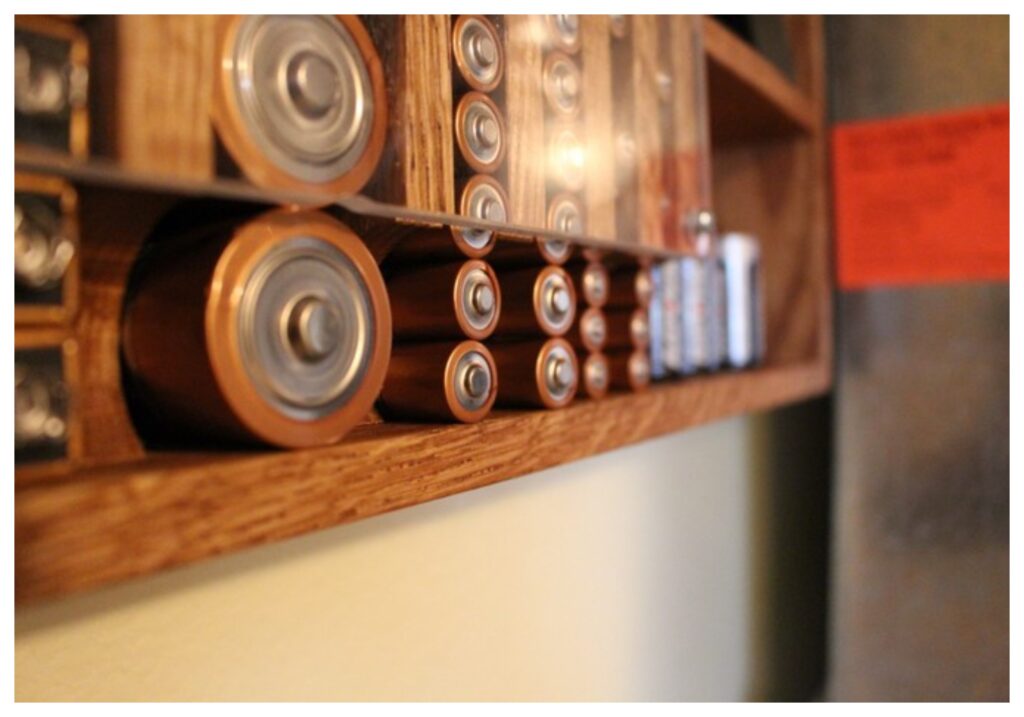
Plus, you can easily see which type of batteries need replenishing. This dispenser can hold up many batteries and can be mounted on a wall or shelf for easy access. It’s certainly a lot simpler and more efficient than batteries all jumbled together in a drawer.
Depending on how many batteries you need to keep at home, you can make your own battery dispenser a little taller or shorter than what is indicated in the plan provided below. If you need to store a lot of batteries, you can make the dispenser taller in order to accommodate more batteries. Alternatively, if you only need to store a few batteries, you can make the dispenser shorter.
This DIY drop-down battery organizer can really come in handy for people who frequently use battery-operated tools and equipment like DIY-ers or photographers!
Do you know anyone who needs this battery dispenser? Why not make one as a gift for them? 
Key Features of a Drop-Down Battery Dispenser
A drop-down battery dispenser is a convenient and innovative solution for organizing and dispensing batteries efficiently. With its user-friendly design and practical features, it offers a seamless experience for storing and accessing batteries of various sizes. Let’s delve into the key features of a drop-down battery dispenser and explore how it enhances convenience and organization:
1. Compact Design
A drop-down battery dispenser typically boasts a compact and space-saving design, making it suitable for countertops, shelves, or mounting on walls. Its sleek profile ensures it seamlessly integrates into any space without occupying excessive room.
2. Multiple Battery Capacity:
One of the standout features of a drop-down battery dispenser is its ability to accommodate batteries of various sizes and types. From standard AA, AAA, C, and D batteries to button cell batteries, it offers versatile storage options to meet different power needs.
3. Transparent Casing
Many drop-down battery dispensers feature a transparent casing or front panel, allowing users to easily view the battery inventory at a glance. This transparency enhances visibility, enabling quick identification of battery types and quantities without the need to open the dispenser.
4. Easy Access
The drop-down mechanism facilitates effortless access to batteries. With a simple pull or push motion, users can retrieve batteries from the dispenser with minimal effort. This convenient accessibility ensures swift battery replacement, especially in urgent situations.
5. Segmented Compartments
To further enhance organization, some drop-down battery dispensers feature segmented compartments or dividers. These partitions help categorize batteries by size or type, preventing them from mixing and ensuring a tidy and well-organized storage solution.
6. Quick Refilling
Refilling a drop-down battery dispenser is a straightforward process. Many models feature a hinged lid or access panel that allows for easy battery replenishment. This user-friendly design eliminates the hassle of cumbersome refilling procedures, saving time and effort.
7. Mounting Options
For added versatility, some drop-down battery dispensers come with mounting options. They may include built-in mounting holes or adhesive strips for secure attachment to walls, cabinets, or other surfaces. This feature enables users to optimize space utilization and keep batteries within arm’s reach.
8. Battery Tester Integration
Advanced drop-down battery dispensers may incorporate built-in battery testers or voltage indicators. These integrated features allow users to quickly assess the remaining power level of batteries before use, ensuring they are always prepared with fully charged batteries.
9. Durable Construction
Durability is a key aspect of a drop-down battery dispenser’s design. Constructed from sturdy materials such as plastic or metal, it is built to withstand daily use and maintain its functionality over time. This robust construction ensures long-term reliability and performance.
10. Versatile Applications
Drop-down battery dispensers find applications in various settings, including households, offices, workshops, and commercial environments. Whether used for powering electronic devices, toys, remote controls, or flashlights, they offer a convenient and organized solution for battery storage and access.
The features of a drop-down battery dispenser combine practicality, convenience, and versatility to offer an efficient solution for organizing and dispensing batteries. With its compact design, transparent casing, easy access mechanism, and other innovative features, it simplifies battery management and ensures users always have access to the power they need.
Learn how to build this battery dispenser by viewing the plan and watching the video below!
You’ll need these materials:
- 1/2″ thick Wood
- 1/4″ thick Hardboard / Plywood
- Clear Acrylic Sheet
- Wood Screw
- Wood Glue
And these tools:
- Table Saw
- Wood Clamps
- Hole Saw
- Drill
- Ruler and Marker
Click on any image to start the lightbox display. Use your Esc key to close the lightbox.![]()
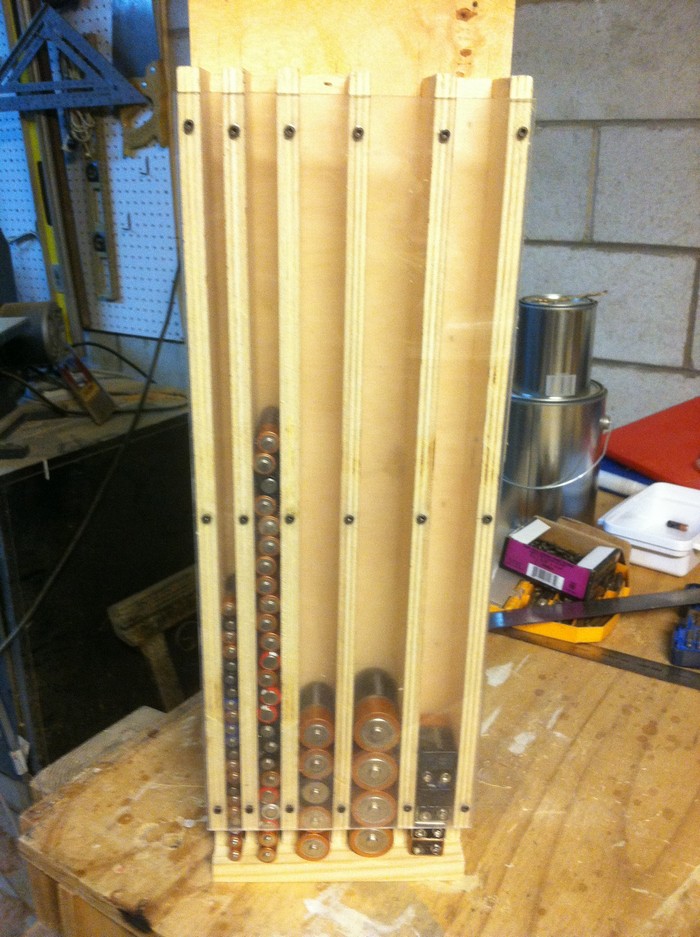
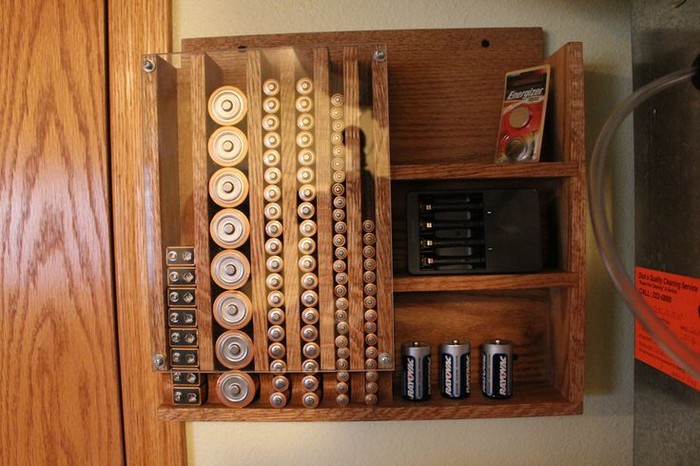
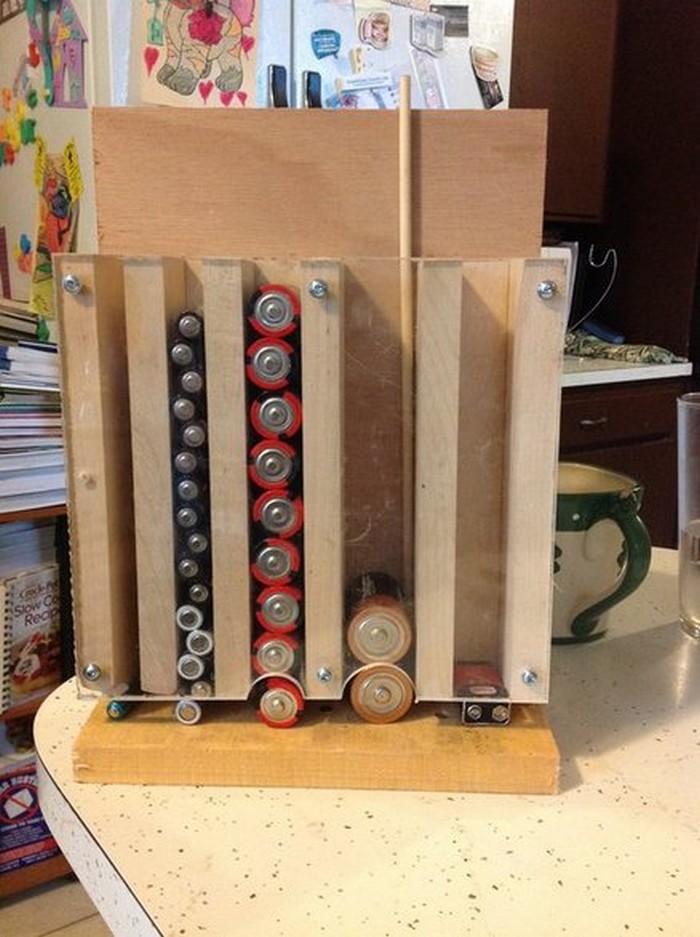
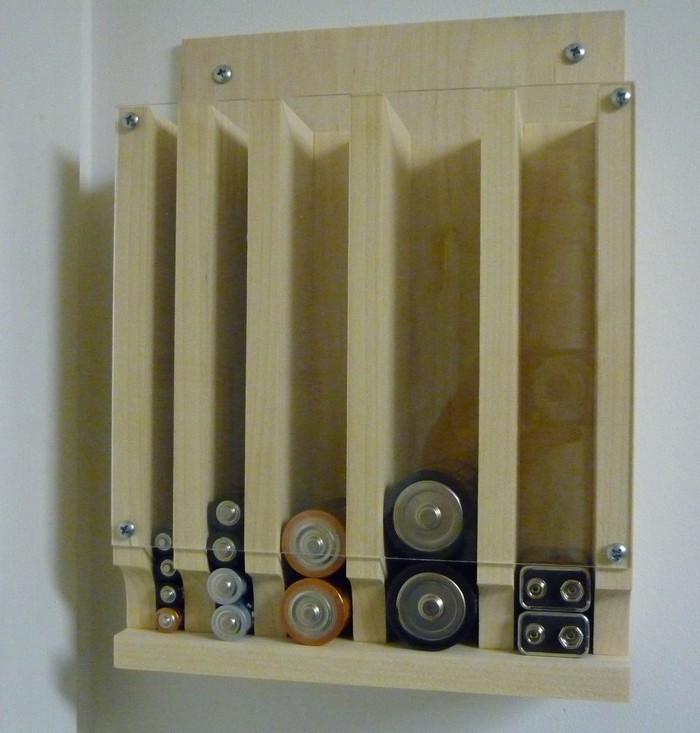

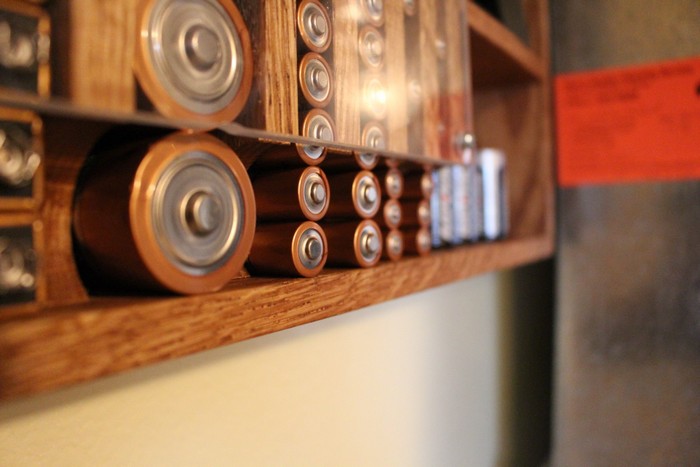


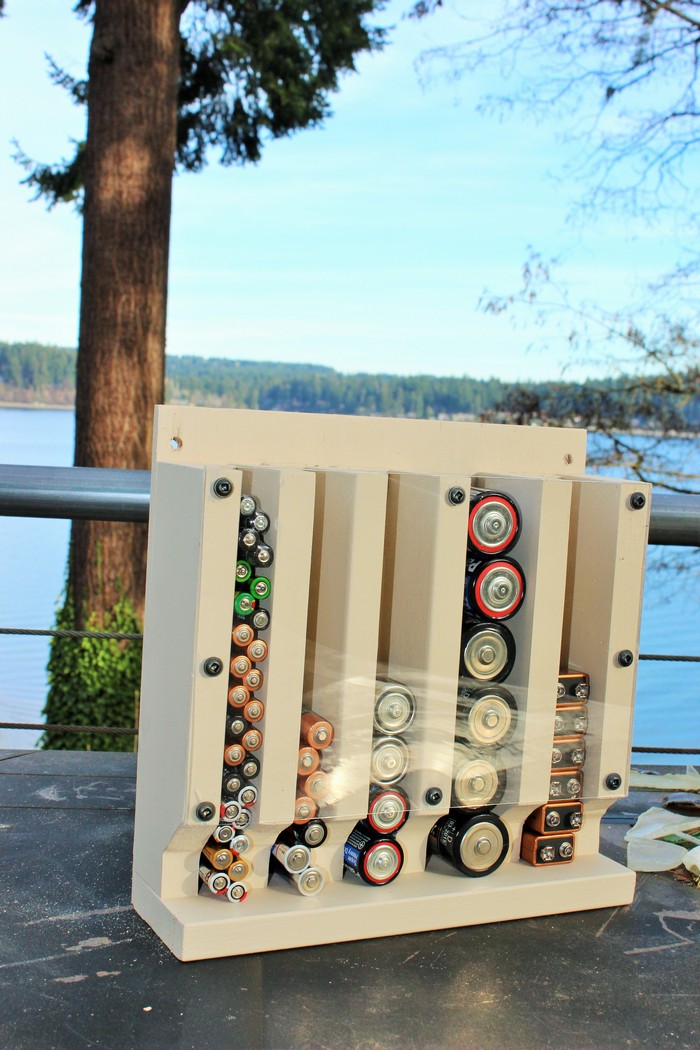

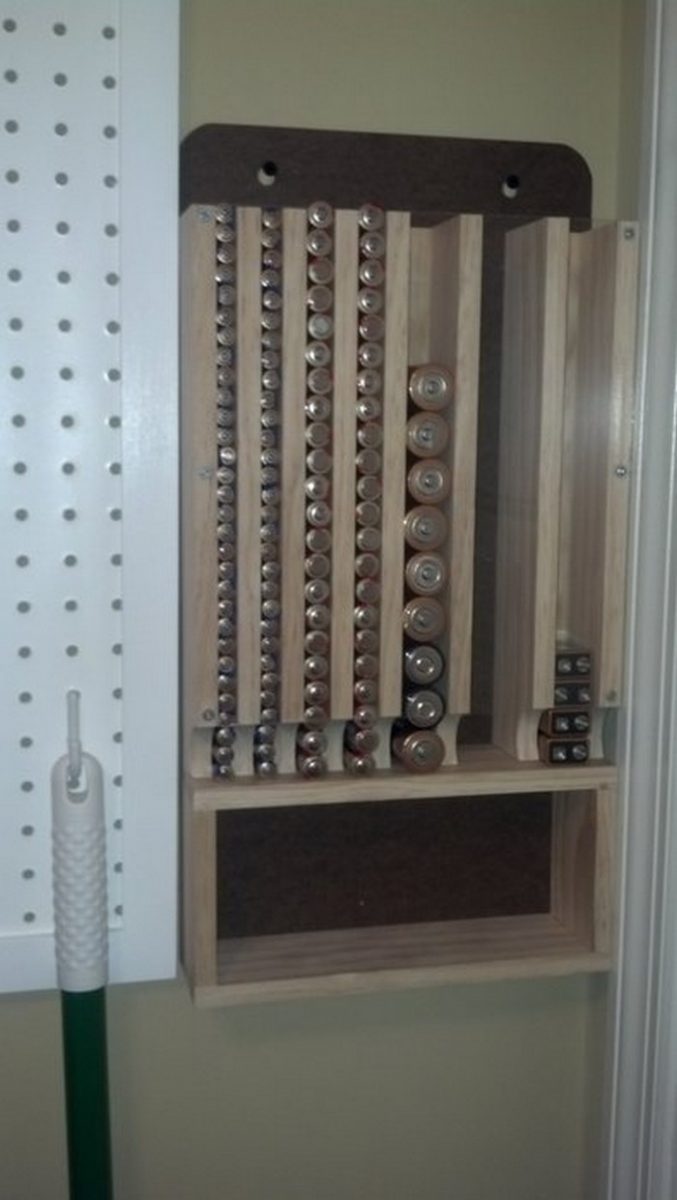

You can watch the step-by-step tutorial from Fun With Woodworking here:
Building a drop-down battery dispenser from simple materials is a practical and efficient way to organize batteries while maximizing space. However, ensuring safety throughout the construction process is paramount to prevent accidents and ensure the longevity of the dispenser. Here are some essential safety precautions to consider when building an efficient drop-down battery dispenser:
1. Select Suitable Materials
Before starting the project, ensure that the materials you choose are appropriate for constructing a battery dispenser. Opt for sturdy and durable materials that can withstand the weight of batteries without bending or breaking. Avoid using materials that are prone to splintering or cracking, as they may pose safety hazards during construction and use.
2. Wear Personal Protective Equipment (PPE)
When handling tools and materials, always wear appropriate personal protective equipment (PPE) to prevent injuries. This may include safety goggles to protect your eyes from flying debris, gloves to shield your hands from cuts and abrasions, and a dust mask to avoid inhaling dust particles.
3. Use Tools Safely
Handle tools with care and follow manufacturer instructions for safe operation. Ensure that tools are in good working condition and free from defects before use. When using power tools such as drills or saws, maintain a firm grip and keep hands and fingers away from moving parts to avoid accidents.
4. Work in a Well-Ventilated Area
When working with adhesives, paints, or other chemicals, ensure that you are in a well-ventilated area to prevent exposure to harmful fumes. Open windows and doors or use fans to improve air circulation and minimize the risk of respiratory irritation or intoxication.
5. Follow Electrical Safety Practices
If the construction process involves wiring or electrical components, adhere to electrical safety practices to prevent electric shocks or fires. Turn off power sources before working on electrical installations and use insulated tools to avoid contact with live wires.
6. Secure Work Area
Maintain a clean and organized work area to minimize tripping hazards and prevent accidents. Clear clutter from walkways and ensure that tools and materials are stored properly when not in use. Secure workpieces with clamps or vices to prevent them from moving unexpectedly during construction.
6. Take Precautions Against Falls
If working at heights, such as when installing the dispenser on a wall or ceiling, take precautions to prevent falls. Use sturdy ladders or scaffolding and ensure that they are set up on stable ground. Wear fall protection equipment such as harnesses and safety belts if necessary.
7. Handle Batteries Safely
When handling batteries, exercise caution to avoid electrical shocks or chemical leaks. Follow manufacturer instructions for proper handling and disposal of batteries, and avoid exposing them to extreme heat or moisture. Keep batteries away from children and pets to prevent accidental ingestion.
8. Test Dispenser Before Use
Once the drop-down battery dispenser is constructed, thoroughly test its functionality before use. Ensure that the dispenser operates smoothly and securely holds batteries without the risk of falling or jamming. Make any necessary adjustments to improve performance and reliability.
9. Regular Maintenance
After completing the construction, perform regular maintenance checks on the battery dispenser to ensure its continued safety and functionality. Inspect for any signs of wear, damage, or malfunction and address issues promptly to prevent accidents or injuries.
By following these safety precautions, you can build an efficient drop-down battery dispenser safely and securely. Remember to prioritize safety at every step of the construction process to minimize risks and create a reliable storage solution for your batteries.
The Wrap Up
In the journey of constructing an efficient drop-down battery dispenser from just five simple materials, we’ve embarked on a journey of creativity, practicality, and resourcefulness. As we conclude this project, it’s essential to reflect on the significance and outcomes of our endeavour.
First and foremost, the creation of this drop-down battery dispenser underscores the power of innovation and DIY solutions. By harnessing everyday materials and employing basic construction techniques, we’ve demonstrated that effective organization and convenience can be achieved without extravagant expenses or complex designs. This project serves as a reminder that sometimes, the most elegant solutions are also the simplest.
The efficiency of the drop-down battery dispenser lies in its ability to optimize storage and accessibility. With designated compartments for various battery sizes and a user-friendly drop-down mechanism, this dispenser streamlines the process of storing and retrieving batteries. By eliminating clutter and confusion, it enhances efficiency in our daily routines and contributes to a more organized living space.
Additionally, the construction of the drop-down battery dispenser promotes sustainability and environmental consciousness. By repurposing materials and minimizing waste, we’ve minimized our ecological footprint and embraced a more eco-friendly approach to organization. This project serves as a testament to the importance of mindful consumption and responsible use of resources in our quest for practical solutions.
Building this dispenser fosters a sense of empowerment and accomplishment. Through hands-on construction and problem-solving, we’ve gained valuable skills and confidence in our ability to tackle DIY projects. This experience serves as a reminder of the satisfaction that comes from creating something useful with our own hands, regardless of prior expertise or technical knowledge.
The construction of an efficient drop-down battery dispenser from five simple materials has been a fulfilling and rewarding journey. It has not only provided us with a practical solution for battery storage but has also imparted valuable lessons in creativity, sustainability, and self-sufficiency.
As we conclude this project, let us carry forward the spirit of innovation and resourcefulness into future endeavours, knowing that with determination and ingenuity, we can continue to create solutions that enhance our lives and our world.
Frequently Asked Questions
1. What materials are required to build the drop-down battery dispenser?
Building the drop-down battery dispenser requires sturdy cardboard or plywood, adhesive tape or glue, hooks or clips, a small bungee cord or elastic band, and a dowel or rod.
2. Are there specific measurements for the dispenser?
While there are no strict measurements, you’ll need to customize the dispenser to fit your battery sizes. It’s advisable to measure the length, width, and height of the batteries to determine the size of the compartments.
3. Do you need specialized tools for construction?
No specialized tools are necessary. Basic household items such as scissors, a utility knife, a ruler, and a pencil are sufficient for the construction process.
4. Can you modify the design to suit different battery types?
Yes, the design can be adapted to accommodate various battery sizes, including AA, AAA, C, D, and 9V batteries. You can adjust the size of the compartments accordingly.
5. How do you mount the dispenser?
The dispenser can be mounted on a wall or inside a cabinet using adhesive hooks, screws, or mounting brackets. Ensure the mounting method is secure and can support the weight of the dispenser and batteries.
6. Is the dispenser suitable for all types of batteries?
Yes, the drop-down battery dispenser is designed to accommodate various types of batteries, including alkaline, rechargeable, and specialty batteries.
7. How do you refill or replace batteries in the dispenser?
Refilling or replacing batteries is simple. Open the drop-down compartment and insert or remove batteries as needed. Ensure the compartment is securely closed after refilling to prevent spills.
8. Can the dispenser be used in commercial settings?
Absolutely! The dispenser’s versatility makes it suitable for various settings, including offices, workshops, and garages. Its compact size and convenient design make it ideal for organizing batteries in any space.
9. How can you ensure the dispenser is durable and long-lasting?
Use high-quality materials and secure construction techniques to ensure durability. Reinforce seams and joints with additional adhesive tape or glue, and periodically check for any signs of wear or damage.
10. Can you customize the appearance of the dispenser?
Yes, you can personalize the dispenser by painting it or adding decorative elements to match your decor or personal style.
11. Are there any safety considerations when building or using the dispenser?
Ensure that the dispenser is securely mounted to prevent it from falling and causing injury. Also, be cautious when handling sharp objects such as utility knives during construction.
12. Is the dispenser environmentally friendly?
Yes, using cardboard or plywood for construction and reusing batteries promotes environmental sustainability.

